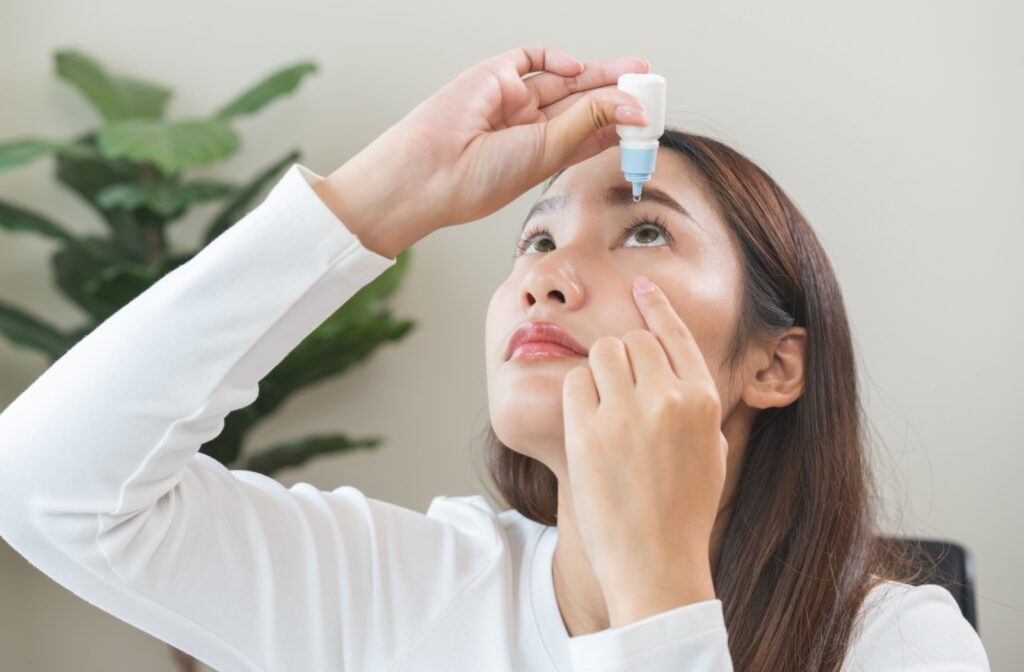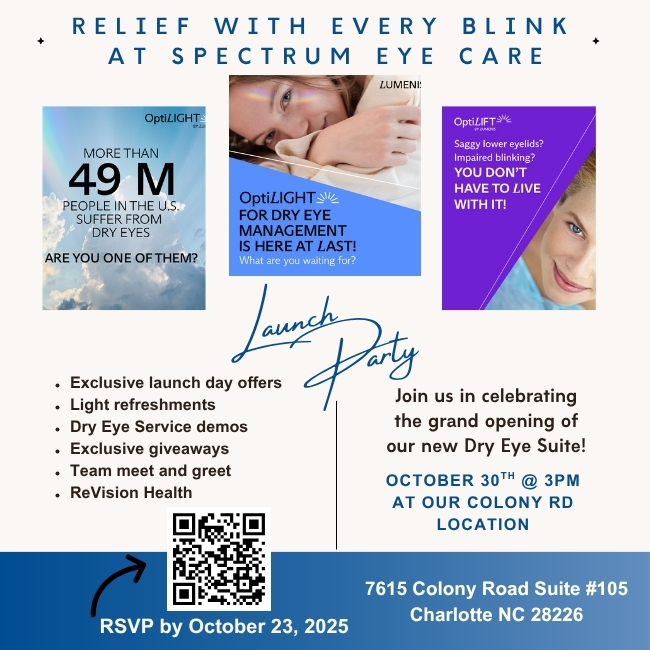If you’ve been dealing with persistent dry eyes, you might wonder whether this condition can lead to serious vision problems. The constant irritation, burning, and discomfort can make you worry about what might happen if your symptoms get worse. At Spectrum Eye Care, we understand these concerns and want to provide you with clear, evidence-based information about dry eye treatment.
Dry eye disease itself does not cause blindness, but if it’s left untreated for a long time, the resulting irritation or surface damage can occasionally affect vision quality.
The good news is that these complications are extremely rare, and with proper treatment and regular monitoring, you can keep your eyes comfortable and your vision clear. The bigger concern is your day-to-day comfort.
What Is Dry Eye Disease & How It Affects Vision
The Tear Film & How It Works
Your tears aren’t just water, they’re a complex mixture of oils, water, and proteins that work together to keep your eyes healthy. This tear film covers your cornea and provides lubrication every time you blink.
When your tear film becomes unstable or inadequate, your eyes can’t stay properly moisturised. This leads to inflammation and damage to the surface of your eye over time, which research shows increases with aging due to immune system changes.
Common Causes of Dry Eye in Charlotte
Living in Charlotte presents unique challenges for your eye health. Several factors contribute to dry eye symptoms in our area:
- Age-related changes in tear production
- Digital eye strain from increased screen use
- Environmental factors including pollen and humidity changes
- Medical conditions like diabetes and autoimmune disorders
- Contact lens wear that disrupts natural tear flow
- Hormonal changes during menopause or pregnancy
Can Dry Eyes Actually Cause Blindness
The Direct Answer: Risk Is Low
Complete blindness from dry eyes is uncommon, but vision impairment can occur. Most people with dry eye disease experience discomfort rather than serious vision threats.
However, ignoring severe symptoms can lead to complications that affect your sight. According to the National Eye Institute, early treatment helps prevent these more serious problems from developing.
When Dry Eye Becomes Dangerous
Severe dry eye can cause your cornea to become damaged from constant irritation. Without enough tears to protect and heal your eye surface, small injuries can become infected.
Stage 4 dry eye — the most severe form — can create corneal thinning and perforation in rare cases. These complications require immediate medical attention to preserve your vision.
Corneal Damage & Scarring Risks
Your cornea needs constant moisture to stay clear and healthy. When dry eye becomes chronic, your corneal surface can develop small abrasions that don’t heal properly.
Over time, these micro-injuries can form scar tissue that clouds your vision. This scarring process happens gradually, which is why regular monitoring is so important for your long-term eye health. Our team explains this process in detail when discussing potential lasting damage from untreated dry eyes.
How Long It Takes for Serious Complications
Vision-threatening complications typically develop over months or years of untreated severe dry eye. The progression varies from person to person based on the underlying cause and severity of symptoms.
Early intervention can stop this progression and help your eyes heal. That’s why we recommend addressing dry eye symptoms as soon as they interfere with your daily activities.
 Warning Signs That Need Immediate Attention
Warning Signs That Need Immediate Attention
Symptoms You Shouldn’t Ignore
Charlotte’s mix of humid summers, dry winters, and high pollen counts can make dry eye symptoms more noticeable. Here are some of the most common causes we see at Spectrum Eye Care:
- Age-related changes: Tear production naturally slows with age, leaving eyes feeling drier and more irritated.
- Digital eye strain: Long hours on computers or phones reduce blinking and cause tears to evaporate faster.
- Environmental factors: Air conditioning, wind, and seasonal pollen can disrupt tear film stability.
- Medical conditions: Diabetes, thyroid issues, and autoimmune disorders like Sjögren’s syndrome often contribute to dryness.
- Contact lens wear: Lenses can interfere with natural tear flow, especially in dry or allergen-heavy environments.
- Hormonal changes: Menopause, pregnancy, and hormonal therapies can affect tear production.
Even mild dryness can worsen over time if left untreated. Our team can identify the root cause and recommend relief options tailored to Charlotte’s climate and your lifestyle.
Stage 4 Dry Eye & Severe Complications
Stage 4 dry eye represents the most advanced form of this condition. At this level, your corneal surface shows significant damage and your symptoms severely impact your quality of life.
People with stage 4 dry eye often experience constant discomfort and may have difficulty with activities like reading or driving. Professional treatment becomes necessary to prevent permanent vision changes.
When Vision Loss Can Be Reversed
Many vision problems from dry eye can improve with appropriate treatment. Surface damage often heals once your tear film stabilises and inflammation decreases.
However, corneal scarring may cause permanent vision changes. This is why we focus on preventing complications rather than treating them after they occur.

Dry Eye Treatment Options in Charlotte
Initial Treatment Approaches
Most people find relief with conservative treatments that address the underlying causes of their dry eye symptoms. Simple remedies like warm compresses can help unblock oil glands and improve tear quality:
- Artificial tears and preservative-free lubricating drops
- Lifestyle modifications to reduce digital eye strain
- Environmental changes like using humidifiers
Advanced Treatments for Severe Cases
When initial treatments aren’t enough, we have several advanced options available. Our IPL therapy treatment uses targeted light pulses to improve meibomian gland function:
- Punctal plugs to help retain your natural tears
- IPL therapy to improve oil gland function
- LipiFlow treatment for blocked meibomian glands
- Prescription medications to reduce inflammation
Prevention & Managing Daily Life with Dry Eye
Protecting Your Eyes in Charlotte’s Climate
Charlotte’s changing seasons can trigger dry eye flare-ups. Spring pollen, summer heat, and winter indoor heating all affect your tear film stability.
Wraparound sunglasses help protect your eyes from wind and allergens when you’re outdoors. Indoor air purifiers can reduce irritants that worsen your symptoms during high pollen seasons. Understanding UV protection is essential for comprehensive eye care.
Screen Time Management for Digital Workers
Many Charlotte residents work in front of computers for extended periods, which reduces blink rates and increases dry eye symptoms. The 20-20-20 rule helps: look at something 20 feet away for 20 seconds every 20 minutes.
Adjusting your screen position so you look slightly downward can also help. This position allows your eyelids to cover more of your eye surface, reducing tear evaporation.
Contact Lens Adjustments
Contact lenses can worsen dry eye symptoms, but you don’t necessarily need to stop wearing them. Daily disposable lenses often work better than extended-wear options for people with dry eyes.
We can help you find contact lenses designed specifically for dry eye sufferers through our specialized contact lens fittings. These specialised lenses retain moisture better and cause less irritation throughout the day.
Can You Drive Safely with Dry Eyes?
Dry eyes can affect your driving safety, especially at night or in bright sunlight. Glare sensitivity and fluctuating vision make it harder to see clearly while driving.
Using lubricating drops before driving and wearing polarised sunglasses can help improve your comfort and vision. If your symptoms interfere with safe driving, it’s time to seek professional treatment.
Eye Exams & Professional Care in Charlotte
How Dry Eye Is Diagnosed
Diagnosing dry eye involves several tests that measure your tear production and quality. We examine your eyelids, check your tear film stability, and assess the health of your corneal surface using advanced retinal imaging technology.
Special diagnostic equipment helps us determine the type and severity of your dry eye condition. This information guides our treatment recommendations and helps us monitor your progress over time.
What to Expect During Your Visit
Your dry eye evaluation includes a comprehensive eye exam plus specific tests for tear function. We’ll discuss your symptoms, medical history, and any medications that might contribute to your condition.
The appointment typically takes about an hour, and most tests are comfortable and non-invasive. You’ll leave with a clear understanding of your condition and a personalised treatment plan.
Follow-up Care & Monitoring Progress
Dry eye treatment often requires adjustments based on how you respond to initial therapies. Regular follow-up appointments help us monitor your progress and modify your treatment plan as needed.
We track changes in your symptoms and corneal health over time. This ongoing monitoring helps prevent complications and ensures you maintain comfortable, healthy vision.
Finding Specialised Care in South End & Uptown Areas
Access to experienced eye care makes a significant difference in managing dry eye disease effectively. We understand the unique challenges Charlotte residents face with seasonal allergies and urban environmental factors.
Our convenient locations in South End, Uptown, and South Charlotte make it easy to receive consistent care. We use advanced diagnostic technology to provide comprehensive dry eye treatment tailored to your specific needs.
Don’t let dry eye symptoms interfere with your vision or quality of life. Contact Spectrum Eye Care today to schedule a comprehensive evaluation and learn about the treatment options that can help protect your sight and provide lasting relief.




